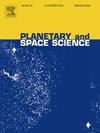Diurnal temperature cycle models and performances on Martian surface using in-situ and satellite data
IF 1.7
4区 物理与天体物理
Q3 ASTRONOMY & ASTROPHYSICS
引用次数: 0
Abstract
Martian surface temperature and its diurnal variations play a key role in studying Mars land-atmosphere interactions. However, accurate Diurnal Temperature Cycle (DTC) models on Martian surface are presently absent or have large uncertainties. This study aims to construct semi-empirical DTC models of the Martian surface and address this gap by assessing their performances. Utilizing in-situ data collected by the Viking 1, Insight, Perseverance, and Curiosity rovers, we assess the performances of these DTC models by examining overall accuracy, daily precision, error rates across various hours, and effectiveness during different Martian seasons. The parameters of the models gain insights into the seasonal variations of surface temperature on Mars. Additionally, we conduct a focused analysis on the parameter-reduction approaches (PRAs) to assess the potential suitability of DTC models with the constraints of limited satellite observations available for Mars. Results indicate that the DTC models can effectively capture the diurnal surface temperature variations on Mars, with an overall error ranging from 0.74 to 2.28 K. Among the DTC models, the DMT24 model developed in this study shows the superior performance and can reproduce the slow and smooth increase around sunrise and maintain accuracy during nighttime periods. The DTC models can well capture the diurnal surface temperature cycle on Mars using limited satellite data based on suitable PRAs. This study offers valuable references for utilizing global DTC models on Mars.
基于原位和卫星数据的火星表面日温度循环模型及其性能
火星表面温度及其日变化在研究火星陆地-大气相互作用中起着关键作用。然而,精确的火星表面日温度循环(DTC)模型目前缺乏或有很大的不确定性。本研究旨在构建火星表面的半经验DTC模型,并通过评估其性能来解决这一空白。利用海盗1号、洞察号、毅力号和好奇号火星车收集的现场数据,我们通过检查总体精度、每日精度、不同小时的错误率以及不同火星季节的有效性来评估这些DTC模型的性能。这些模型的参数可以深入了解火星表面温度的季节性变化。此外,我们对参数约简方法(pra)进行了重点分析,以评估DTC模型在有限的火星卫星观测约束下的潜在适用性。结果表明,DTC模型可以有效地捕捉火星地表温度的日变化,总体误差在0.74 ~ 2.28 K之间。在DTC模型中,本研究开发的DMT24模型表现出较好的性能,可以再现日出前后缓慢平稳的增长,并在夜间保持精度。DTC模型可以利用有限的卫星数据,基于合适的pra,很好地捕捉火星表面的日温度周期。该研究为在火星上应用全球DTC模型提供了有价值的参考。
本文章由计算机程序翻译,如有差异,请以英文原文为准。
求助全文
约1分钟内获得全文
求助全文
来源期刊

Planetary and Space Science
地学天文-天文与天体物理
CiteScore
5.40
自引率
4.20%
发文量
126
审稿时长
15 weeks
期刊介绍:
Planetary and Space Science publishes original articles as well as short communications (letters). Ground-based and space-borne instrumentation and laboratory simulation of solar system processes are included. The following fields of planetary and solar system research are covered:
• Celestial mechanics, including dynamical evolution of the solar system, gravitational captures and resonances, relativistic effects, tracking and dynamics
• Cosmochemistry and origin, including all aspects of the formation and initial physical and chemical evolution of the solar system
• Terrestrial planets and satellites, including the physics of the interiors, geology and morphology of the surfaces, tectonics, mineralogy and dating
• Outer planets and satellites, including formation and evolution, remote sensing at all wavelengths and in situ measurements
• Planetary atmospheres, including formation and evolution, circulation and meteorology, boundary layers, remote sensing and laboratory simulation
• Planetary magnetospheres and ionospheres, including origin of magnetic fields, magnetospheric plasma and radiation belts, and their interaction with the sun, the solar wind and satellites
• Small bodies, dust and rings, including asteroids, comets and zodiacal light and their interaction with the solar radiation and the solar wind
• Exobiology, including origin of life, detection of planetary ecosystems and pre-biological phenomena in the solar system and laboratory simulations
• Extrasolar systems, including the detection and/or the detectability of exoplanets and planetary systems, their formation and evolution, the physical and chemical properties of the exoplanets
• History of planetary and space research
 求助内容:
求助内容: 应助结果提醒方式:
应助结果提醒方式:


